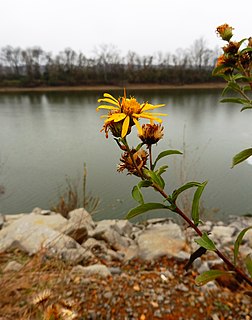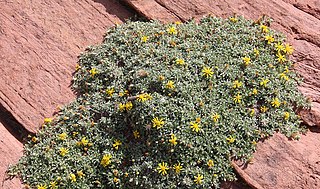
Chrysopsis, are plants in the family Asteraceae native to the southern and eastern United States. All the species are found in Florida, although some are found in other states as well.

Heterotheca, are North American plants in the family Asteraceae.
Heterotheca oregona is a species of flowering plant in the family Asteraceae known by the common name Oregon false goldenaster. It is native to the west coast of Canada and the United States in British Columbia, Washington, Oregon, and California as far south as Los Angeles County.

Heterotheca sessiliflora is a species of flowering plant in the family Asteraceae known by the common name sessileflower false goldenaster. It is native to California, Sonora, and Baja California.
Chrysopsis delaneyi, or DeLaney's goldenaster, is one of the endemic species to the U.S. state of Florida, recently discovered in the genus Chrysopsis, a small group of herbaceous plants of the family Asteraceae, known commonly as the "golden asters" and primarily native and restricted to Florida.

Chrysopsis mariana, known as the Maryland golden-aster, is a North American species of plants in the family Asteraceae. The Maryland golden-aster ranges from Rhode Island and New York, west to Kentucky and southern Ohio, and south as far as Florida and Texas.

Chrysopsis floridana is a rare species of flowering plant in the family Asteraceae, known by its common name, Florida golden aster. It is endemic to Florida in the United States, where it is known from Hillsborough, Hardee, Manatee, and Pinellas Counties. It is considered an endemic of the west-central coast of the state in the general vicinity of Tampa Bay. There are 17 to 20 occurrences, many of which have few individuals, but one of which has over one million plants. In 1986 the plant was added to the US endangered species list because it was becoming increasingly rare, it was growing only on private property, and its habitat was unprotected and being destroyed and degraded by a number of forces. It is found at Bell Creek Nature Preserve in Riverview, Florida.
Trichoptilus pygmaeus is a moth of the family Pterophoridae. It is found in North America, including California, Florida and British Columbia.

Bradburia pilosa, the soft goldenaster, is a North American species of flowering plants in the family Asteraceae, native to the south-central United States, primarily the southeastern Great Plains and lower Mississippi Valley, in the states of Texas, Oklahoma, Kansas, Missouri, Arkansas, Louisiana, Tennessee, Mississippi, and Alabama. Additional populations are reported farther east but these appear to be introductions.
Chrysopsis godfreyi, or Godfrey's goldenaster, is a North American species of flowering plant in the family Asteraceae. It is native to the states of Florida and Alabama in the southeastern United States.
Chrysopsis gossypina, the cottony goldenaster, is a North American species of flowering plant in the family Asteraceae. It is native to the Coastal Plain of the southeastern United States, from eastern Louisiana to southeastern Virginia.
Chrysopsis highlandsensis, called the Highlands goldenaster, is a North American species of flowering plant in the aster family. It has been found only in three counties in central Florida: Highlands, Polk, and Glades.
Chrysopsis lanuginosa, called the Lynn Haven goldenaster, is a North American species of flowering plant in the family Asteraceae. It has been found only in the Florida Panhandle.
Chrysopsis subulata, called the scrubland goldenaster, is a North American species of flowering plant in the family Asteraceae. It has been found only in Florida.
Chrysopsis linearifolia, the narrowleaf goldenaster, is a North American species of flowering plant in the family Asteraceae. It has been found only in Florida.
Chrysopsis latisquamea, the pineland goldenaster, is a North American species of flowering plant in the family Asteraceae. It has been found only in Florida.

Heterotheca camporum, known by the common name lemonyellow false goldenaster, is a North American species of flowering plant in the family Asteraceae. It is found only in the central United States, primarily the Ozarks, the Cumberland Plateau, and the middle Mississippi Valley. There are reports of additional populations in the Northeast, the Southeast, and in the Great Lakes region, but these appear to be waifs or naturalizations.

Heterotheca jonesii, known by the common name Jones's goldenaster, is a rare North American species of flowering plant in the family Asteraceae. It has been found in the southern part of the state of Utah in the United States.

Heterotheca rutteri, the Huachuca goldenaster or Rutter's false goldenaster, is a rare North American species of flowering plant in the family Asteraceae. It has been found only in the Huachuca and Santa Rita Mountains of southern Arizona and northern Sonora.
Heterotheca viscida, called the cliff goldenaster, is a North American species of flowering plant in the family Asteraceae. It grows on cliffs and ledges in mountainous regions. It grows in the southwestern United States, primarily in Arizona, New Mexico and southern Texas with reports of isolated populations in Nevada, southeastern Idaho, and southeastern Colorado.










